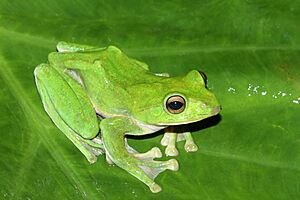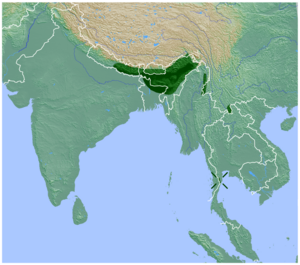Zhangixalus smaragdinus facts for kids
Quick facts for kids Zhangixalus smaragdinus |
|
|---|---|
 |
|
| Conservation status | |
| Scientific classification | |
 |
|
| Rhacophorus maximus range. | |
| Synonyms | |
|
The Zhangixalus smaragdinus is a fascinating type of frog. It has several common names, including the Nepal flying frog, Günther's tree frog, and giant treefrog. This frog is part of the Rhacophoridae family. You can find it in various parts of Asia, such as southwestern China (in Yunnan and Tibet), northeastern India, Nepal, western Thailand, and northern Vietnam. It might also live in Bangladesh.
Contents
Where Does This Frog Live?
The Zhangixalus smaragdinus frog makes its home in moist evergreen forests. These are forests where trees stay green all year round. It lives in areas from lowlands up to the lower parts of mountains.
How High Can This Frog Be Found?
These frogs have been seen living at different heights above sea level. They can be found anywhere from about 500 meters (about 1,640 feet) to 2,000 meters (about 6,560 feet) high.
What Does This Frog Do?
When it's not the breeding season, this frog is mostly arboreal. This means it lives high up in the trees, often in the very top parts of the forest, called the canopy.
Reproduction and Life Cycle
When it's time to have babies, the Zhangixalus smaragdinus frog lays its eggs in special nests. These nests are made of foam and are built above pools and ponds. This helps protect the eggs until they hatch.
Is This Frog Safe from Extinction?
Good news! The Zhangixalus smaragdinus frog is not in danger of disappearing. The IUCN (International Union for Conservation of Nature) says it is a species of "least concern." This means there are plenty of them around.
Why Is It Not Endangered?
One big reason this frog is safe is because it lives in a very large area. This area includes many protected parks and reserves in different countries. These safe places help the frogs live and reproduce without too much danger.
Protected Homes of the Frog
Some of the special places where these frogs are protected include:
- Xishuangbanna National Nature Reserve in China
- Dihang-Dibang Biosphere Reserve in India
- Royal Manas National Park in Bhutan
- Phibsoo Wildlife Sanctuary in Bhutan
- Jigme Singye Wangchuck National Park in Bhutan
- Phu Luang Wildlife Sanctuary in Thailand
- Thong Pha Phum National Park in Thailand
- Kaeng Krachan National Park in Thailand
- Kui Buri National Park in Thailand
How Do People Interact with This Frog?
In some parts of India, people sometimes catch these frogs. They are caught for food to help feed families. This is usually done in small amounts and does not harm the overall frog population.


